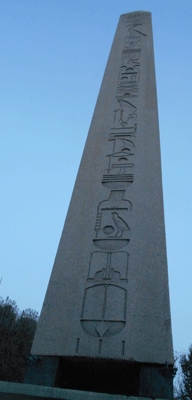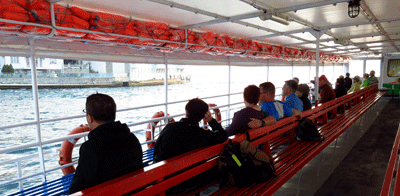Crossing to Byzantium
Once out of nature I shall never take
My bodily form from any natural thing,
But such a form as Grecian goldsmiths make
Of hammered gold and gold enamelling
To keep a drowsy Emperor awake;
Or set upon a golden bough to sing
To lords and ladies of Byzantium
Of what is past, or passing, or to come.
A taxi ride across the Galata Bridge demonstrated the traffic congestion, exacerbated during this week of Kurban Bayramı, or the Feast of the Sacrifice, celebrating the Biblical and Kur’anic account of Abraham’s near-sacrifice of his son to prove his faithfulness to God. Following this tradition, the head of each Turkish household either sacrifices a food animal on which friends and family are invited to feast, with the excess meat (or a money donation) made to charity. The festival forced some small changes to our Istanbul itinerary, but otherwise wasn’t an inconvenience.
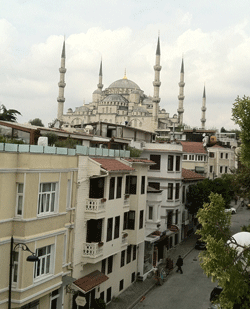 The group lodging, Hotel Azade, is ideally located near many of the major points of historical interest in Istanbul’s Sultanhamet district, and we were able to walk just about everywhere. After checking in, we headed to the rooftop terrace restaurant (with a fantastic panoramic view!) for an orientation session, with snacks of course. Our guide Mert introduced himself and gave us some information on the schedule and tour protocols, which included choosing our “buddies” — the intelligent Rick Steves way of making sure nobody gets left behind by having each person pair up with someone in the group with whom they are not connected as family, spouse, or travelling companion. Then we set out for Topkapi Palace and the Hippodrome, looking back into the history of the city.
The group lodging, Hotel Azade, is ideally located near many of the major points of historical interest in Istanbul’s Sultanhamet district, and we were able to walk just about everywhere. After checking in, we headed to the rooftop terrace restaurant (with a fantastic panoramic view!) for an orientation session, with snacks of course. Our guide Mert introduced himself and gave us some information on the schedule and tour protocols, which included choosing our “buddies” — the intelligent Rick Steves way of making sure nobody gets left behind by having each person pair up with someone in the group with whom they are not connected as family, spouse, or travelling companion. Then we set out for Topkapi Palace and the Hippodrome, looking back into the history of the city.
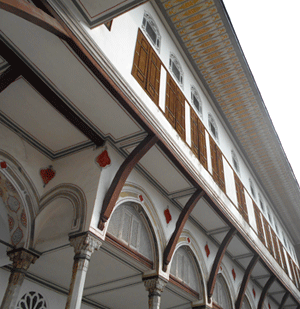 Topkapı is unlike any European concept of a palace, being a extensive complex of hundreds of pavilions and courtyards, and serving as the administrative center of the empire as well as the residence of the Sultan and his family. Entrance is through a series of courtyards; the first is open to the public and serves as a lovely park. The Gate of Salutation leads to the Second Courtyard, used for important ceremonies such as coronations. Beyond are more gates, courtyards, buildings in styles from various eras, and gardens. We concentrated on visiting the opulent rooms of the harem and viewing the treasury collections (the three emeralds in the hilt of the Topkapı dagger really are worth stealing!), then relaxed by strolling around the grounds and admiring the spectacular views of the Bosphorus Strait, Asian Istanbul, and the Sea of Marmara.
Topkapı is unlike any European concept of a palace, being a extensive complex of hundreds of pavilions and courtyards, and serving as the administrative center of the empire as well as the residence of the Sultan and his family. Entrance is through a series of courtyards; the first is open to the public and serves as a lovely park. The Gate of Salutation leads to the Second Courtyard, used for important ceremonies such as coronations. Beyond are more gates, courtyards, buildings in styles from various eras, and gardens. We concentrated on visiting the opulent rooms of the harem and viewing the treasury collections (the three emeralds in the hilt of the Topkapı dagger really are worth stealing!), then relaxed by strolling around the grounds and admiring the spectacular views of the Bosphorus Strait, Asian Istanbul, and the Sea of Marmara.
Even dinner was no respite from archeology. Before sitting down to our first delicious group dinner at Albura Kathisma (on Akbiyik or “Restaurant” Street), we took time to explore some partially excavated ruins of a cistern from the Byzantine Magnaura Palace, accessible through the restaurant. (Many structures dating from the Byzantine period, or even earlier, are on privately owned property, in Istanbul and other parts of Turkey; some underground cisterns and the like are still used for storage of food or other commodities.)
Speaking of cisterns, among the sights not included in the tour itinerary was the the Yerebatan Underground Cistern, something we definitely did not want to miss, so Susie and I made a point to include it during our explorations of the Old District the previous day. There was a very long queue, but an enterprising local guide working the line offered a private tour (and no wait) which seemed very reasonable. A few other tourists joined us and we slipped in. Wow. Built over a basilica and designed to complement its architecture with graceful Roman columns, this is the largest underground reservoir built in Constantinople during Justinian’s reign: supported by 336 columns and holding over 27 million gallons of fresh water, its area is twice the size of a football field. Impressions from photos of the cistern, and memories of the Bondian rendezvous in From Russia With Love, are completely inadequate; the cistern is beautiful and magical, and even the tourist crowd was dwarfed by its majesty. Definitely one of my favorite Istanbul sights.
Next morning began one of those days listed as “strenuous” on the tour info sheet. We had an early start to visit the Blue Mosque (Sultanhamet Camii) ahead of the larger crowds, which was a good plan. This grand structure, completed in 1616, is one of the finest mosques in the world and very popular with both tourists and devout Muslims. The huge dome, 141 feet high with a diameter of 110 feet, was modelled after the one in the older Hagia Sophia and creates a vast open indoor space. The opulence of the mosque’s decorations are overwhelming: some of the floral-design stained glass windows are original, as are rare examples of the most famous of Iznik tiles (accounting for the “Blue Mosque” designation). Fluted marble columns support the dome, and gold geometric designs and calligraphy add to the impression of majesty. The Blue Mosque is also famous for having six minarets, requested by Sultan Ahmet as a symbol of his wealth. However, this upstaged the mosque in the holy city of Mecca, so the sultan built Mecca a seventh minaret. (That probably didn’t detract from his status.)
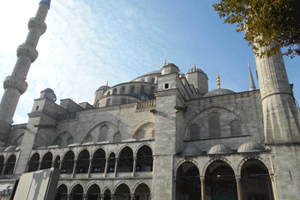 Hagia Sophia — church, mosque, and now a museum — is the single greatest architectural achievement of the Byzantine empire and one of the most important structures in the world. Built by Justinian between 532 and 537 AD, it served as the seat of the Orthodox Patriarch of Constantinople for 900 years. After the conquer of the city by the Ottomans, it was converted into an imperial mosque, which purpose it served until the 1930s when it became a museum. The current structure supersedes at least two previous churches, and the construction of the 185 foot high dome was one of the great architectural challenges of the age. Byzantine mosaics and frescoes were plastered over in the fifteenth century, which in some cases helped preservation although many of the original pieces were damaged or destroyed over time. At present, many of these works of art have been preserved and can be viewed throughout the building. The Ayasofya Müzesi web site has an extensive collection of gorgeous photos, but this is one of Istanbul’s monument treasures that just must be visited to be appreciated. Adjust your plans accordingly.
Hagia Sophia — church, mosque, and now a museum — is the single greatest architectural achievement of the Byzantine empire and one of the most important structures in the world. Built by Justinian between 532 and 537 AD, it served as the seat of the Orthodox Patriarch of Constantinople for 900 years. After the conquer of the city by the Ottomans, it was converted into an imperial mosque, which purpose it served until the 1930s when it became a museum. The current structure supersedes at least two previous churches, and the construction of the 185 foot high dome was one of the great architectural challenges of the age. Byzantine mosaics and frescoes were plastered over in the fifteenth century, which in some cases helped preservation although many of the original pieces were damaged or destroyed over time. At present, many of these works of art have been preserved and can be viewed throughout the building. The Ayasofya Müzesi web site has an extensive collection of gorgeous photos, but this is one of Istanbul’s monument treasures that just must be visited to be appreciated. Adjust your plans accordingly.
From Hagia Sophia, we boarded our bus and crossed the Golden Horn to the New District for a short free-form visit. Since Susie and I had spent two nights here previously, we checked out a few places we hadn’t been: Taksim Square at the top of Istaklal Street and the Pera Palace Hotel. Once the ne plus ultra for travellers arriving in Istanbul on the Orient Express, the Pera Palace retains its elegance and has a lovely display of historical items (such as the original elevator) on display and a small museum commemorating one of its most famous visitors, Agatha Christie. There was time for a quick döner lunch and a wander through a used book fair next to the hotel, then back on the bus to visit the Chora Church.
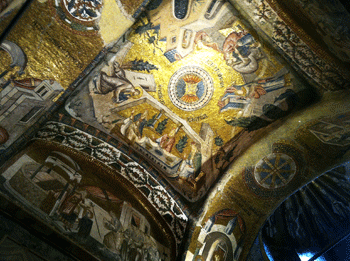 An underappreciated destination (possibly because of its location outside the Sultanhamet district), the Kariye Müzesi (Chora Museum) is home to the best-preserved collections of late Byzantine frescoes and mosaics anywhere in the world. The first church on this site, the Church of St. Savior in Chora (chora meaning “outside” — ie, outside the city walls), dates from the fourth century; the current structure was built in the 11th century and restored and richly decorated in the 14th. When the church was converted into a mosque in the 16th century, the Byzantine mosaics were covered in plaster, which protected them for several centuries. First uncovered in the 1800s, restoration of the artworks was carried out by the Byzantine Institute of America from 1948–1959. The scope and beauty of the art is staggering. The Chora Museum web site has photos of each image, with detailed descriptions and historical information, well worth checking out.
An underappreciated destination (possibly because of its location outside the Sultanhamet district), the Kariye Müzesi (Chora Museum) is home to the best-preserved collections of late Byzantine frescoes and mosaics anywhere in the world. The first church on this site, the Church of St. Savior in Chora (chora meaning “outside” — ie, outside the city walls), dates from the fourth century; the current structure was built in the 11th century and restored and richly decorated in the 14th. When the church was converted into a mosque in the 16th century, the Byzantine mosaics were covered in plaster, which protected them for several centuries. First uncovered in the 1800s, restoration of the artworks was carried out by the Byzantine Institute of America from 1948–1959. The scope and beauty of the art is staggering. The Chora Museum web site has photos of each image, with detailed descriptions and historical information, well worth checking out.
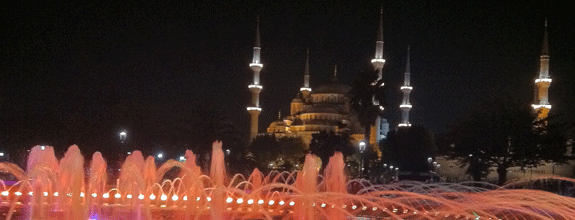
Return to Turkey 2014 Index


